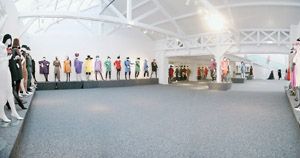 Pierre Cardin turned his life into a museum to "leave a trace". Under the light of a glass roof, 130 mannequins dressed in the most emblematic models of his style, lined up on two levels along the walls, illustrate the "working life" of this often avant-garde couturier.
Pierre Cardin turned his life into a museum to "leave a trace". Under the light of a glass roof, 130 mannequins dressed in the most emblematic models of his style, lined up on two levels along the walls, illustrate the "working life" of this often avant-garde couturier.
Grey coat with black buttons, beige suit with cowl neck in the back, pleated poppy coat, cream coat-dress... A dozen pieces summarize the beginnings of Pierre Cardin, one of the first employees of Christian Dior in 1946.
Further on,the “more cosmic period” of 1965 - 70 begins: dresses printed with large, colorful geometric motifs, or cut with two round holes from which the breasts emerge, red suits whose cut draws pointed nipples. "It was provocative over 40 years ago", Cardin points out, convinced that "Jean-Paul Gaultier and all the others" have taken up his ideas.
Trouser suits designed for athletes at the Munich Olympics (1972) stand side by side with short skirts in black or red vinyl, chasuble dresses, others in metal or with molded reliefs. Evening and cocktail dresses take the form of long black silhouettes, with steel collars and bibs inspired by Citroën bumpers and made by a coachbuilder, or, on the contrary, bursting with bright colors and 3D, with folds, straps and inflated volumes. Dozens of accessories are also on display: hats, shoes, glasses, jewelry (enamel, metal, plastic, vinyl), belts, masks. The museum has between 600 and 700 garments in its reserves.
The Collection, which had been on display for several years in Saint-Ouen (bd Victor Hugo), moved to the 4th arrondissement of Paris in November 2014. In spring 2025, the Pierre Cardin Collection will move into a 500 m² space in the couturier's first Parisian boutique at 59 Rue du Faubourg Saint-Honoré.
In 1945, Pierre Cardin arrives in Paris, where he works for Paquin, then Schiaparelli. He met Jean Cocteau and Christian Berard, with whom he designed numerous costumes and masks for films such as "Beauty and the Beast". In 1946, he joined Christian Dior. In the 1950s, Pierre Cardin opened two stores and presented his first collection, "Robes Bulles", which was a triumph. In 1958, he received the "Young Designers" prize from the city of Boston (USA).
During the 1960s, Pierre Cardin created the first men's ready-to-wear collection, and a Pierre Cardin prize was created for the best designer of the year at the Bunka Fukuso School of Fashion Design. In 1966, he was awarded the "Golden Spinning Wheel" prize in Germany. In the late 1960s and early 1970s, Pierre Cardin opened three stores. The 1970s were award years. Pierre Cardin received four awards: the EUR prize (Italian cinema Oscar), the "Basillica Palladiana" prize, twice the "Dé D'Or" and finally the "Prestige du tourisme" diploma. At the end of the 1970s, he opened five stores, including the "Evolution" furniture store.
The 1980s were a rich period for Pierre Cardin. He received numerous awards, including the Orchidée d'Or and the Dé d'Or. He received several French awards, including the Chevalier des Arts et des Lettres. During this period, Pierre Cardin opened up to new horizons in interior design, cuisine, perfume and jewelry. During the 1980s, he opened more than a dozen boutiques and restaurants. During the 1990s, Pierre Cardin's success continued to grow. He brought out new perfumes, launched a make-up brand, opened more than a dozen stores and restaurants, and became an Honorary Ambassador for UNESCO. He was also decorated several times (the Order of the Sacred Treasure, for example).
In the 2000s, Pierre Cardin launched several magazines, including Imprévu. He received several decorations and awards, including the Star Étoile Prize from the Savannah Calloge of Art and Design. In 2004, a tribute was paid to him at Printemps Haussman with fashion shows and various events. In 2006, a museum named "Passé-Présent-Futur" was opened, where many of his works can be seen. He continues to open stores and restaurants around the world, but much less so than in the 1990s.
Pierre Cardin dies in 2020.